
This vase is made with kakishibu, a dye made from persimmons. The vase was a gift from my in-laws, who brought it back from a trip to Shikoku. The bright red of the keitou flower (celosia argentea, or plumed cockscomb) seems to overwhelm the film.
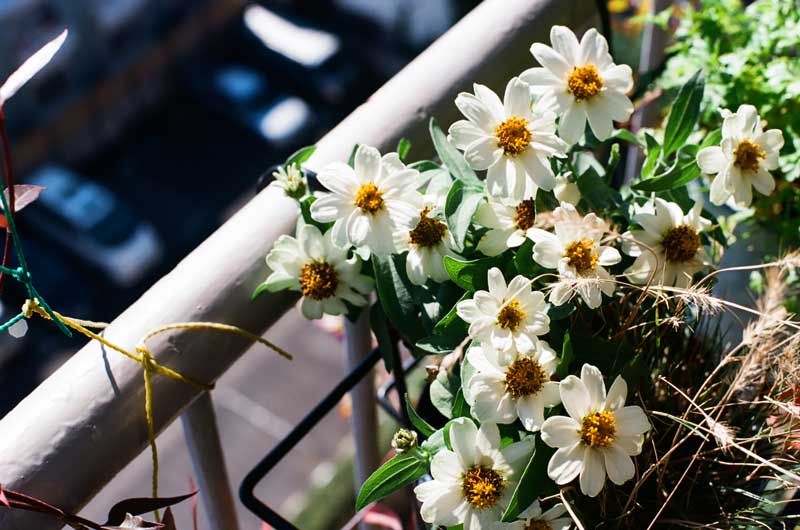
ベランダのデイジーがまだ咲いています。フィルムの色と質感が面白いと思います。
These white and yellow daisies are still blooming on my balcony garden. The parking lot is 10 floors down. I’ve combined the daisies with a small grass for contrast. I like the color and texture of this film photo.

The strawberry patch on my balcony has been a pleasure to look at and to eat. The fruits are small, and the flavor concentrated. I am also amazed by how black the dark areas are when shooting with film.

最近、たくさんフィルムの写真をとっています。マクロレンズを使うと、ベランダのジャングルで特定の要素が見えます。これは、琉球アサガオです。背景に、都庁やハイヤットやオペシティがあります。ところで、「シティ」という日本語の発音はとても変です。
Recently I am taking a lot of film photos, and recently I bought a macro lens which allows me to focus on specific elements of the jungle that my balcony is becoming. This is Okinawa morning glory, the mainstay of our green curtain.
In the background you can see the twin towers of Tokyo Metropolitan Government, the Hyatt hotel from Lost in Translation, and the Opera City building. The last building always makes me laugh because the Japanese pronunciation is “opera shitty.”

毎週金曜日、東京で再稼働反対のデモがあります。このフィルムの写真は新宿の小さなデモでとりました。コズプレも音楽も、いろいろな人たちが居て楽しいです。この抗議は原発の問題がよい方向に変わるのではないかと思わせてくれます。
There are protests in front of the Prime Minister’s Residence every Friday in favor of ending nuclear power. The protests have been the largest and most sustained since the 1960s. The national government and largest corporations are eager to re-start the plants that were shut down after the Fukushima nuclear crisis.
I often join a Koenji group’s demonstrations. These photos are from a smaller march. I like the range of people, the costumes, music, and sense of fun and hope. These are all film photos.






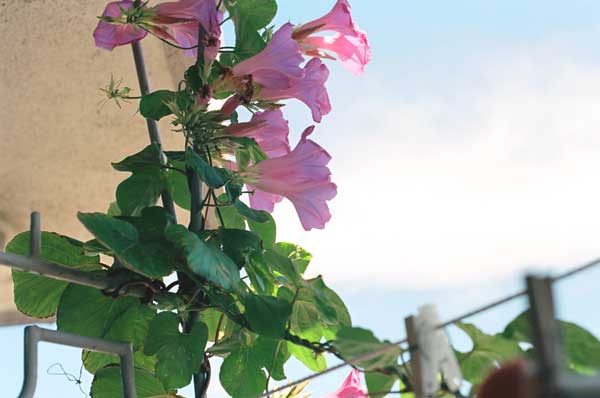
Early in the day, this Okinawa morning glory is a deep blue with lots of large blooms. I like how by afternoon, the flowers turn pink as they wilt.

I picked up three short kikyou plants at the home center, without knowing much about them. Later I learned that kikyou, also known as bellflower, are one of Japan’s seven fall flowers (yet oddly active in summer). Kikyou is also related to campanula, which spread rapidly in my shady San Francisco garden with abundant purple flowers.
In the (film) photo background, you can see the sprouts of New York tomatoes that I grew from seeds. I’ve shared the seedlings with many friends already.
I also discovered these cool black and white Japanese crests (kamon) based on kikyou. (Source: Wikipedia).


最近買った中古のフィルムカメラで、黒白フィルムを使いました。アサガオの濃い青色の花も緑の葉も強いですが、カラーのフィルムより詳しく形が見えます。蟻も見えます。
With my new film camera, a 10 year old model, I tried out a roll of black and white film. I like how the color is taken away from the deep blue flower and dark green leaves of this morning glory. Instead you can see the form more carefully. I like how you can even see some of the many ants that have inhabited the balcony garden and green curtain.
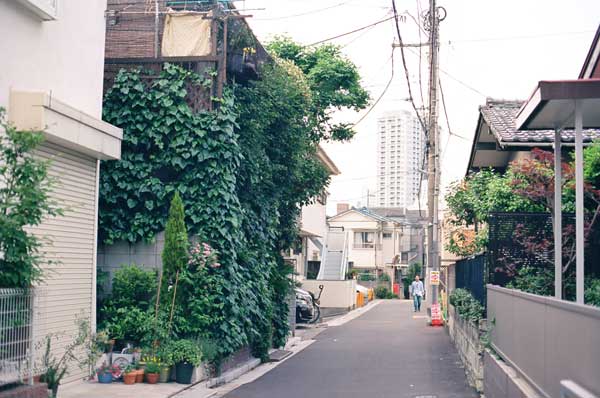
This film photograph of the mysterious Nakano forest house looks so much different than the digital one I posted recently. I love how green and over-grown this house has become.
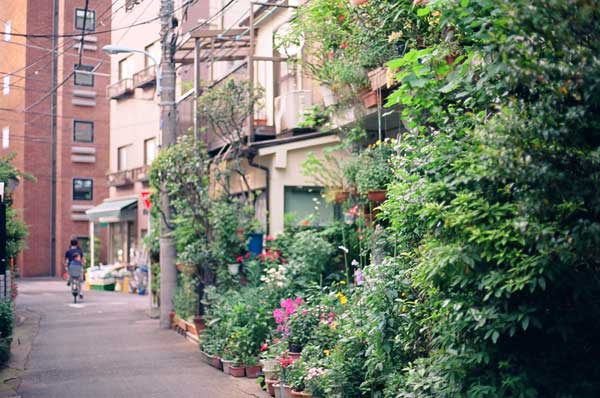
最初のフィルムに、一番好きな中野と新宿の庭の写真をとりました。飯島さんの花の壁はとても素敵です。Plant Journal という雑誌の記事に、インタビューをしました。訪ねたときに、飯島さんは、「今、何も咲いていません」と言っていました。フィルムなので、イメージが古く見えますね。
For my first roll of film, I took photos of my favorite gardens in Nakano and Shinjuku, plus my own balcony garden. In the foreground above is Iijima-san’s flower wall house. He has 500 hundred potted plants, mostly flowers, rising from the street to the roof. I interviewed Iijima-san for the Plant Journal article I wrote recently.
His first sentence in greeting us was, “There’s nothing blooming now.”
It’s funny how using a film camera makes the image itself look older. The texture and colors in this image seem so different than the bright and flat images I am now accustomed to seeing with digital images. In the next days, I’ll put up more images from this first roll.
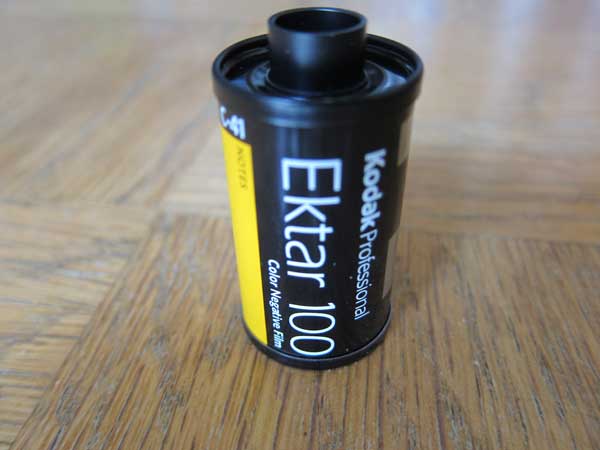
My tiny point and shoot Canon S90 has provided almost all the photos on Tokyo Green Space. Inspired by seeing the revival of film cameras, and assisted by B/B who gave me advice and a tour of Nakano’s famous Fujiya used camera shop, I’ve just started taking film photographs with a super cheap Canon EOS Kiss 5 camera body and a good 50 mm lens.
I’m excited about improving my photography skills, and seeing what film can do. It’s also fun to go to film labs. I took my first roll to Horiuchi’s main office in nearby Wada. The last time I used a professional lab I was a graduate student in Rio de Janeiro, Brazil, in the 1990s. What I like about the Wada location is that, although very close to where I live, I always get lost going there by bike.
